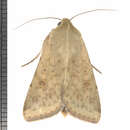Conservation Status
provided by University of Alberta Museums
None. Elsewhere a major agricultural pest.
- license
- cc-by-nc
- copyright
- University of Alberta Museums
Cyclicity
provided by University of Alberta Museums
Adults are on the wing in late August - September.
- license
- cc-by-nc
- copyright
- University of Alberta Museums
Distribution
provided by University of Alberta Museums
Across southern Canada from Nova Scotia to BC, south to Argentina and Chile. In Alberta, recorded as an immigrant north to Dry Island Buffalo Jump Provincial Park in the Red Deer River valley.
- license
- cc-by-nc
- copyright
- University of Alberta Museums
General Description
provided by University of Alberta Museums
A medium-size (3.5-4.5 cm. wingspan) olive-green (males) or olive-brown brown (females) moth. The orbicular is faint and round with a dark pupil, the reniform more prominent and darker. Normal lines are marked by a series of dark dots, and the forewing terminal area is lighter than the remainder of the wing. Hindwings are white with a discal crescent and a wide dark terminal band containing a small pale patch midway along the margin. The green color of the male fades in older museum specimens.
- license
- cc-by-nc
- copyright
- University of Alberta Museums
Habitat
provided by University of Alberta Museums
Ubiquitous in open areas, esp. in croplands.
- license
- cc-by-nc
- copyright
- University of Alberta Museums
Life Cycle
provided by University of Alberta Museums
A very widespread pest species on a wide range of crops. Alberta lies at the northern edge of it's huge range, and there are only a handful of records from southern Alberta. It occurs in Alberta only as a fall immigrant from the south. Adults are mainly nocturnal and come to light. Like other members of the family, the larvae feed mainly on the buds, flowers and developing fruiting bodies of plants, including corn ears, tomatoes, and other vegetable crops.
- license
- cc-by-nc
- copyright
- University of Alberta Museums
Trophic Strategy
provided by University of Alberta Museums
No Alberta data. Elsewhere a vast number of wild and cultivated plants. As the common names imply, a pest on corn, tomatoes and cotton.
- license
- cc-by-nc
- copyright
- University of Alberta Museums

